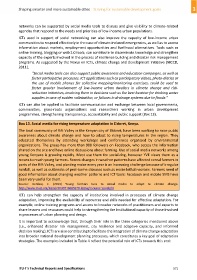Page 581 - Shaping smarter and more sustainable cities - Striving for sustainable development goals
P. 581
networks can be supported by social media tools to discuss and give visibility to climate‐related
agendas that respond to the needs and priorities of low‐income urban populations.
ICTs used in support of social networking can also improve the capacity of low‐income urban
communities to respond effectively in the case of climate‐induced emergencies, as well as to access
information about markets, employment opportunities and livelihood alternatives. Tools such as
online training, blogging or web 2.0 tools; can contribute to disseminate knowledge and strengthen
capacity of the experts involved in the process of resilience building and disaster risk management
programs. As suggested by the Nexus on ICTs, climate change and development initiative (NICCD,
2011),
"Social media tools can also support public awareness and education campaigns, as well as
foster participative processes. ICT applications such as participatory videos, photo‐diaries or
the use of mobile phones for collective mapping/monitoring exercises, could be used to
foster greater involvement of low‐income urban dwellers in climate change and risk‐
reduction initiatives, involving them in decisions such as the best location for drinking water
supplies in case of sudden salinization, or failures in drainage systems due to floods."
ICTs can also be applied to facilitate communication and exchange between local governments,
communities, grass‐roots organisations and researchers working in urban development
programmes, strengthening transparency, accountability and public support (Box 13).
Box 13. Social media for rising temperature adaptation in Eldoret, Kenya.
The local community of Rift Valley in the Kenyan city of Eldoret, have been working to raise public
awareness about climate change and how to adapt to rising temperatures in the region. They
educated themselves by attending workshops and conferences organized by environmental
organizations. The group has more than 900 followers on Facebook, who access the information
shared on the site and have online discussions about farming. Use of social media networks among
young Kenyans is growing rapidly. Most use them for socializing, however YVE views them as a
means to reach young farmers. Recent changes in weather patterns have affected cereal farmers in
parts of the Rift Valley, and planting maize every year is an increasing challenge because of irregular
rainfall, as well as outbreaks of pest‐borne diseases such as maize lethal necrosis. Farmers need of
good information about changing weather patterns and ICT tools: Facebook and mobile SMS have
been very useful for them.
Source: Kemboi, C. (2013) Young farmers turn to social media to adapt to climate change.
http://www.trust.org/item/20130716085920‐k63xg/?source=spotlight
ICTs can help strengthen the capacity of institutions involved in processes of climate change
adaptation, improving the availability of resources and skills needed for effective adaptation. For
example, online training programs and access to broader networks of practitioners and experts to
share lessons and resources could help to strengthening the institutional capacity of those involved
in processes of urban planning and design.
It is important to acknowledge that, through their role in the three categories mentioned above
(i.e., enhanced disaster risk management, city resilience and adaptive capacity, and informed
decision making), ICTs are also contributing to facilitate the integration of climate change adaptation
into broader national development planning processes, which constitutes a key goal of adaptation
strategies. The examples included in Table 4 reflect the potential role of ICTs towards this end:
ITU‐T's Technical Reports and Specifications 571

